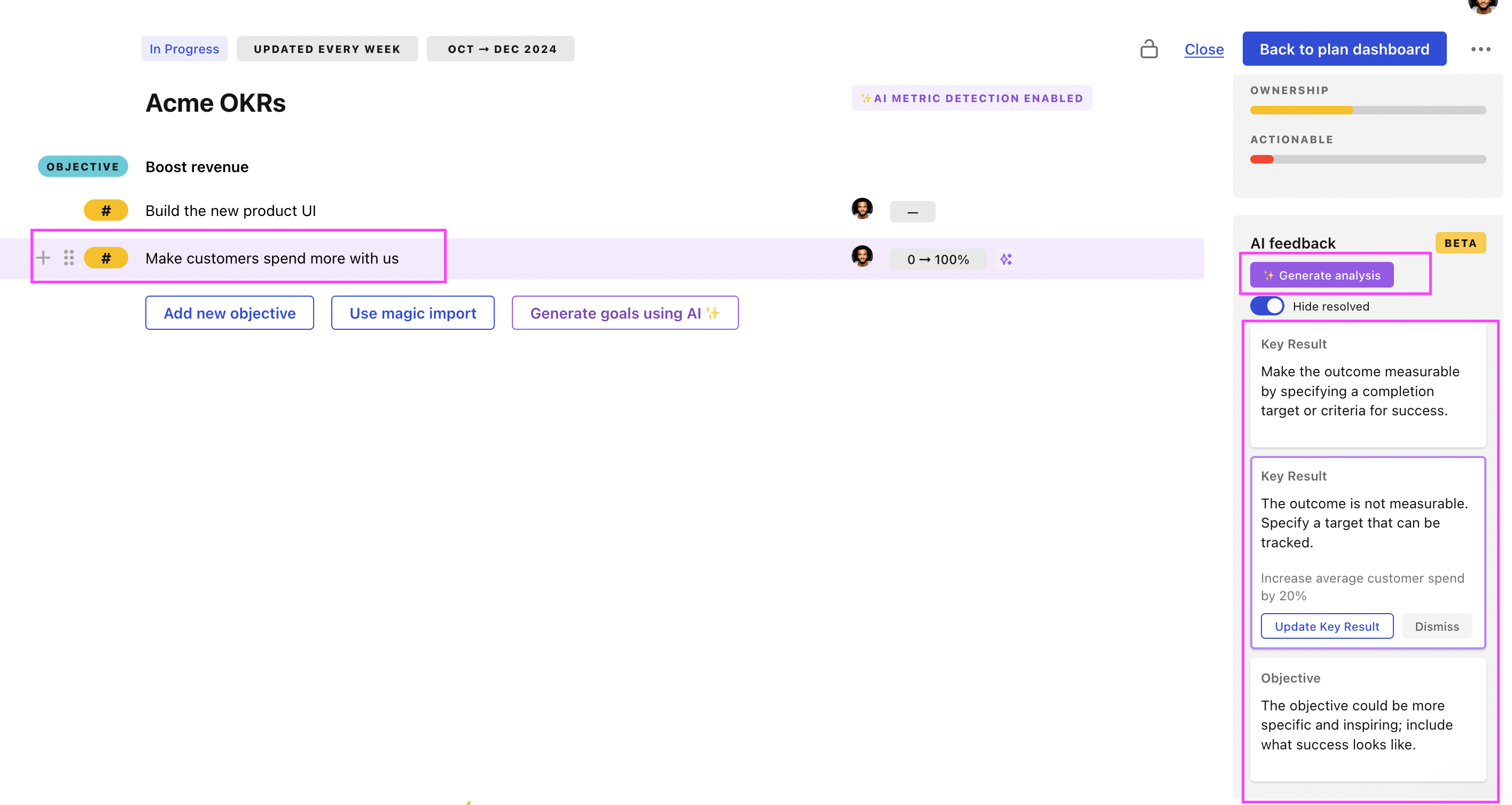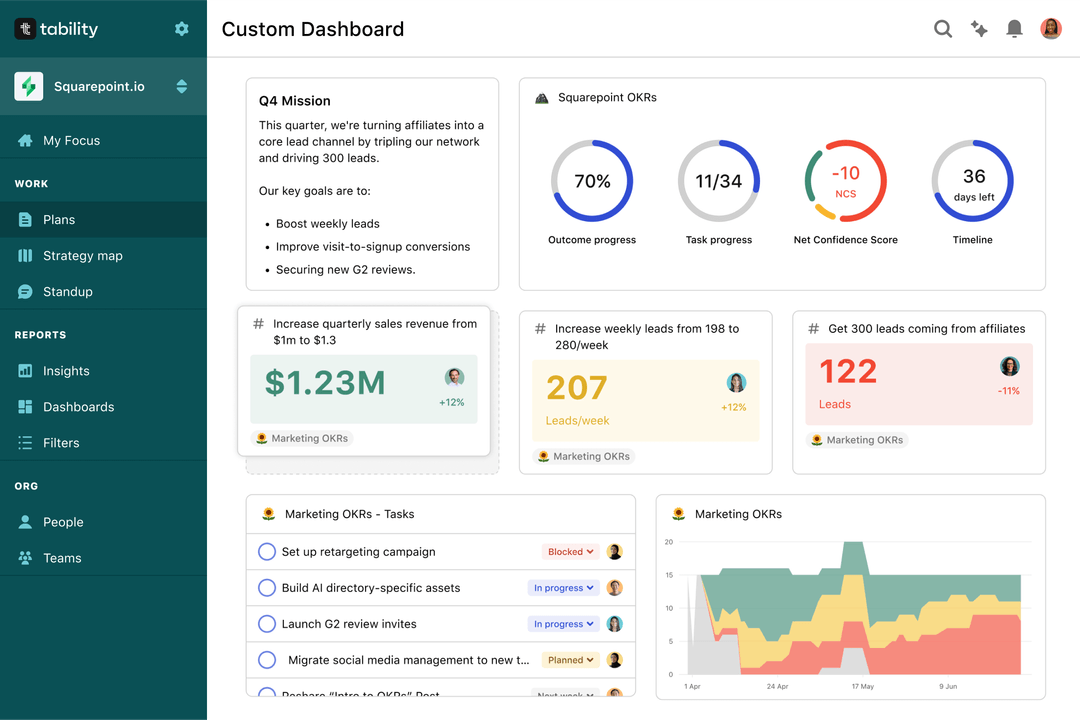Tability is a cheatcode for goal-driven teams. Set perfect OKRs with AI, stay focused on the work that matters.
What are Power Management Team OKRs?
The OKR acronym stands for Objectives and Key Results. It's a goal-setting framework that was introduced at Intel by Andy Grove in the 70s, and it became popular after John Doerr introduced it to Google in the 90s. OKRs helps teams has a shared language to set ambitious goals and track progress towards them.
OKRs are quickly gaining popularity as a goal-setting framework. But, it's not always easy to know how to write your goals, especially if it's your first time using OKRs.
We've tailored a list of OKRs examples for Power Management Team to help you. You can look at any of the templates below to get some inspiration for your own goals.
If you want to learn more about the framework, you can read our OKR guide online.
The best tools for writing perfect Power Management Team OKRs
Here are 2 tools that can help you draft your OKRs in no time.
Tability AI: to generate OKRs based on a prompt
Tability AI allows you to describe your goals in a prompt, and generate a fully editable OKR template in seconds.
- 1. Create a Tability account
- 2. Click on the Generate goals using AI
- 3. Describe your goals in a prompt
- 4. Get your fully editable OKR template
- 5. Publish to start tracking progress and get automated OKR dashboards
Watch the video below to see it in action 👇
Tability Feedback: to improve existing OKRs
You can use Tability's AI feedback to improve your OKRs if you already have existing goals.
- 1. Create your Tability account
- 2. Add your existing OKRs (you can import them from a spreadsheet)
- 3. Click on Generate analysis
- 4. Review the suggestions and decide to accept or dismiss them
- 5. Publish to start tracking progress and get automated OKR dashboards

Tability will scan your OKRs and offer different suggestions to improve them. This can range from a small rewrite of a statement to make it clearer to a complete rewrite of the entire OKR.
Power Management Team OKRs examples
You will find in the next section many different Power Management Team Objectives and Key Results. We've included strategic initiatives in our templates to give you a better idea of the different between the key results (how we measure progress), and the initiatives (what we do to achieve the results).
Hope you'll find this helpful!
OKRs to boost sustainable power for CRM machine uptime
ObjectiveBoost sustainable power for CRM machine uptime
KRAchieve 10% reduction in CRM machine power-related outages by week 9
KREvaluate CRM machine's current power usage by end of week 2
Gather all recent power consumption data for the CRM machine
Review and analyze the collected data thoroughly
Draft a report based on the analysis by end of week 2
KRImplement at least 2 energy efficient upgrades by week 6
Implement chosen energy-efficient upgrades by week 6
Identify potential areas for energy-efficient upgrades
Research and select two effective upgrade options
OKRs to establish uninterrupted power supply for all cable and net nodes during blackouts
ObjectiveEstablish uninterrupted power supply for all cable and net nodes during blackouts
KRImprove system efficiency to achieve less than 1% downtime in case of blackouts
Implement a robust uninterruptible power supply (UPS) system
Regularly test and maintain all backup systems
Develop a comprehensive disaster recovery plan
KRSecure procurement and installation deals of uninterrupted power supply (UPS) systems for 100% of nodes
Finalize procurement contracts for necessary UPS systems
Identify potential UPS system suppliers and initiate negotiation
Organize installation of UPS systems across all nodes
KRImplement and test successful failover to UPS for all nodes during simulated blackout events
Schedule simulated blackout events periodically
Set up and configure UPS systems on all nodes
Monitor and document failover success during simulations
OKRs to enhance ATM availability through sustainable power
ObjectiveEnhance ATM availability through sustainable power
KRAchieve a reduction of power-related ATM downtime by 25%
KRSuccessfully install green power source to 100% of targeted ATMs
Purchase and install appropriate green power sources
Conduct tests to ensure successful installation
Evaluate required energy levels for each target ATM
KRResearch and select the most efficient, green power source by evaluating 5 alternatives
Identify and list down five green power alternatives
Research thoroughly on each power alternative
Choose the most efficient green power source
Power Management Team OKR best practices
Generally speaking, your objectives should be ambitious yet achievable, and your key results should be measurable and time-bound (using the SMART framework can be helpful). It is also recommended to list strategic initiatives under your key results, as it'll help you avoid the common mistake of listing projects in your KRs.
Here are a couple of best practices extracted from our OKR implementation guide 👇
Tip #1: Limit the number of key results
The #1 role of OKRs is to help you and your team focus on what really matters. Business-as-usual activities will still be happening, but you do not need to track your entire roadmap in the OKRs.
We recommend having 3-4 objectives, and 3-4 key results per objective. A platform like Tability can run audits on your data to help you identify the plans that have too many goals.
Tip #2: Commit to weekly OKR check-ins
Don't fall into the set-and-forget trap. It is important to adopt a weekly check-in process to get the full value of your OKRs and make your strategy agile – otherwise this is nothing more than a reporting exercise.
Being able to see trends for your key results will also keep yourself honest.
Tip #3: No more than 2 yellow statuses in a row
Yes, this is another tip for goal-tracking instead of goal-setting (but you'll get plenty of OKR examples above). But, once you have your goals defined, it will be your ability to keep the right sense of urgency that will make the difference.
As a rule of thumb, it's best to avoid having more than 2 yellow/at risk statuses in a row.
Make a call on the 3rd update. You should be either back on track, or off track. This sounds harsh but it's the best way to signal risks early enough to fix things.
Save hours with automated Power Management Team OKR dashboards

OKRs without regular progress updates are just KPIs. You'll need to update progress on your OKRs every week to get the full benefits from the framework. Reviewing progress periodically has several advantages:
- It brings the goals back to the top of the mind
- It will highlight poorly set OKRs
- It will surface execution risks
- It improves transparency and accountability
Spreadsheets are enough to get started. Then, once you need to scale you can use Tability to save time with automated OKR dashboards, data connectors, and actionable insights.
How to get Tability dashboards:
- 1. Create a Tability account
- 2. Use the importers to add your OKRs (works with any spreadsheet or doc)
- 3. Publish your OKR plan
That's it! Tability will instantly get access to 10+ dashboards to monitor progress, visualise trends, and identify risks early.
More Power Management Team OKR templates
We have more templates to help you draft your team goals and OKRs.
OKRs to establish a successful inbound marketing strategy
OKRs to develop robust performance metrics for the new enterprise API
OKRs to streamline graphic design processes
OKRs to accelerate the sales of the medical aid product line
OKRs to achieve compliance with industry standards and regulations
OKRs to implement simplified and automated work processes through expertise